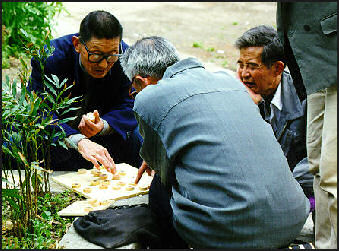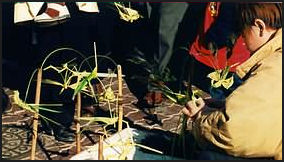GAMES AND GAMBLING IN CHINA

Men playing a board game
Playing cards appear to have to have been introduced to the West from China. The first accounts of playing cards were descriptions by early Western visitors of complicated games using "sheet dice" being played all over China. A popular card game in the Shanghai area is called Beat the Landlord.
”Liubu” was a popular board game in ancient times. In Qin and Han courts it was considered an art form and was a favorite pass time of noblemen. The game was thought to have been played by immortals as well as humans and probably included elements of divination.
Chinese checkers is a simplified version of a Chinese board game called "halma." It was patented around 1880 by a New York-based game maker and originally called Hop Ching Checkers. The Chinese also play games that are similar to checkers and dominoes.
See Separate Article RECREATION, ENTERTAINMENT AND GAMBLING factsanddetails.com
Chess in China
The game of chess was developed in China, where it seems to have originally been a technique of divination used to unravel the meanings hidden in the battle between Yin and Yang. In early Chinese chess the Great Bear, or Northern Dipper, was represented by a spoon that was spun about. The spoon came to be made of magnetite after its seemingly magical properties were discovered, and so served as a divining device when it was rotated according to the complicated rules of the game. These spoons are also regarded by many as the world’s first compasses. [Source: Daniel Boorstin, "The Discoverers"]
Hou Yifan has been one of the top women chess players in the world since she was 12. When she turned 14 in early 2008 she was playing well enough that a grandmaster title seemed imminent. She has beaten a number of grand masters and won an international women’s chess tournament in Istanbul. The New York Times described her as “a natural counter puncher, not an aggressor” who has “the grit and determination and is more apt to wear down opponents than overwhelm them."
Wei-chi (Go) in China
The game of Go — known as “weiqi”or “wei-chi” — is very popular in Chin. Mao was fond of it and reportedly applied the game’s strategy to his own military campaigns. One of the top players in modern China is a beautiful model named Tang Li. The Russel Crowe character in Beautiful Mind played go.
Go is the most popular board game is Japan, Korea and much of China. It is a simple but very complex game of strategy. It is played on a 19-by-19 grid board with black and white circular-stone pieces arranged into intricate patterns.
The rules of Go are very simple: One players with white stones and an other with black stones take turns placing their stones on the 361 intersections of the board. The idea of the game is to capture the stones of an opposing players by occupying all the spaces around his or her stones. This is done by creating complex fence-like structures and enclosing as much territory as possible.
The object is not necessarily to capture the stones of the opposing player put to capture the most territory as represented by points (the intersections on the board).
Professional Go players earn a great deal of money from tournament prizes, TV appearances, teaching and royalties from books and videos.
Origins of Go
The origins of Go are shrouded in mystery. According one legend the game was invented by the legendary Chinese Emperor Yao (2255-2205 B.C.) to improve the mind of his feeble-minded son. In another story it was invented by court astrologers in the Zhou dynasty (1045-244 B.C.). The earliest evidence of the game is a board discovered in a Western Han dynasty (206 B.C.-A.D. 8) tomb.
Most scholars believe the game was invented 3,000 to 4,000 years ago by shaman-astrologers as a method of divination. Some of the game's terminology has astrological roots. The center of the board, for example, is called the "center of heaven" and the points around the perimeter are called “stars”. In addition, the four quarters of the Go board correlate with the basic trigrams of the "I Ching" system.
In 8th century China, Go was one of "The Four Accomplishments" along with calligraphy, painting and lute playing that a gentleman was expected to master. A book called "The Classic of Go" was published in China In a 1050.
Unlike chess, it has been nearly impossible to create a Deep-Blue-like computer program that can defeat a halfway decent Go player, basically because there are so many different moves a Go player can make (about 200 compared to only 35 for a chess player).
Chinese Children’s Games

Handmade grasshopper toy
"Drop the hanky" is a popular children’s game in China as it is many parts of the world. The game begins with a dozen or more children sitting in a circle, facing inward, and singing and clapping their hands. The person who is It drops a hanky behind one player in the circle.
If the seated player realizes the hanky is behind him he gets up and chases the person who is It. If he touches It before It reaches his place the chasing player gets to take back his space. If It reaches the space without behind touched, the chasing person is It. If the seated person doesn’t realize the hanky is behind him and It circles the entire group and picks the hanky and hits the seated player with the hanky then the seated player is It.
Electric Gate is a run and tag children’s game played in China. Two teams, team A and team B, line up on opposite lines, each defending a base. Members of one team try to touch the base of the other team. Lets say, Team A is trying to touch the base of Team B. If a Team B player touches a Team A player the Team A player is frozen until a team mate set him free. A round of the game ends when either the base is touched or all the players are frozen.
Hide and seek is called “eluding the cat” in China. Chinese children also enjoying playing with tops and kites. Sometime two Chinese children play jump rope by standing apart and swinging the rope with their outside hands and then leaping inside the rope and jumping. The jumper than goes out and the partner jumps in. Both partners may jump inside.
Village toys include hoops, push carts, tops, and marbles. Families often have little money for toys and amusements so children learn to make things for themselves: small sailboats made from broken sandals and popsicle sticks; soccer balls made from wadded up plastic bags and twine; pull toys made from sardine cans or plastic bottles; and puppets and dolls made from wood, bamboo and scraps of old clothes. In poor areas rocks are often used as toys.
In China, Barbie is marketed more to young women than it is to little girls. A six-story Shanghai Barbie flagship store opened in 2009 and was dubbed a place where dreams come true. One 23-year-old administrator, with a bag full of Barbie -size pink purses, T-shirts and cupcakes along with six dolls, told the Washington Post, “I just thought, “Wouldn’t this be great if this was my home?” — and described things she saw absolutely “princess-y”
Hello Kitty in China
In May 2011 it was announced that a Hello Kitty Theme Park will be built in Anji, Zhejiang Province and this will be her first home outside Japan since she was created 37 years ago. "Hello Kitty" has been named as the ambassador of Japanese tourism in Chinese mainland and Hong Kong, where she enjoys huge popularity among children and young ladies.
Hello Kitty's parent company, Sanrio, has agreed to work with a Shanghai-based developer to help attract Chinese fans. Visitors to the amusement park will be able to enjoy 3D Games, animated Hello Kitty films and onsite food service. Construction is expected to begin in July, and is projected to open in 2014. [Source: CCTV, May 10, 2011]
Barbie in China
Barbie was first sold in China in theearly 1990s, but it was not until 2009 that she attained superstar status when a flagship store devoted to her opened in downtown Shanghai. Mattel, the world's biggest toy company, marked her 50th birthday by opening the planet's largest Barbie emporium. Covered in pink plastic, the six-storey doll's house on Huaihai Road became an instant landmark. Martial arts star Jet Li and the actor Christy Chung were among the celebrities at its launch. This was more than a party; it was the start of a marketing campaign aimed at prolonging and expanding the lifestyle championed by the toy firm. For the Barbie market to continue to grow for another 50 years, the doll would have to make it big in China. [Source: Jonathan Watts, The Guardian, June 26, 2010, , edited from “When A Billion Chinese Jump“ by Jonathan Watts Faber, 2010 ]
Jonathan Watts wrote in The Guardian, “When I lunch at Barbie's place, in the fantastically kitsch restaurant with the menu...doesn't seem to be hugely popular. Along with Barbie, burgers with Barbie, pink sauce, Ken burgers, pinktastic pasta, doll-icious desserts and Barbie, tini cocktails, the restaurant boasts generous promotional offers: those opting for the special meal receive a boxed set of Barbie plates and cutlery to take away.
“I ask Liu Yunting, who works for an advertising company, what she plans to do with her new tableware. “I will use it myself,” she says. Isn't it a little childish? “Not at all. It is cute. This is much better than the stuff for children. We know better how to appreciate it.”
Failure of Barbie in China
The Shanghai Barbie store was greeted with such fanfare. The three-story, 36,000-square-foot store was a veritable pink shrine to All Things Barbie, with 900 display cases, a cocktail bar, spa, a makeup studio and a runway where young girls could imagine themselves on the catwalk.
Mattel closed is flagshop Barbie store in Shanghai in 2011 after two years, Keith B. Richburg wrote in the Washington Post, “Shanghai was chosen as the site of Mattel’s only flagship store because this was seen as the most sophisticated, modern city in the world’s fastest-growing consumer market. But the Barbie theme never seemed to find a niche among a population where “cute” trumps “sexy,” and where even women in their 20s prefer Hello Kitty to anything too overtly sexual.” [Source: Keith B. Richburg, Washington Post, May 10, 2011]
“Barbie is an American cultural icon,” Li Guangdou, a brand analyst in Shanghai, told the Washington Post . “It is more than a toy. It is also promoting a kind of American culture. Youthfulness, confidence, independence and sex are the selling points of Barbie. But Oriental culture emphasizes more of introversion and introspection.” He added, “There’s a cultural difference.”
Chinese consumers are also extremely price-conscious and are not always ready to pay even a few cents more for an American brand when a similar, less-expensive local model is available. At several Shanghai department stores, sales staff said the local Kurhn brand doll was generally outselling Barbie, largely because of price. And shoppers agreed. “Barbie is too expensive,” said Xu Xiaoyun, a 20-year-old college student who has been collecting dolls since she was young. She has one Barbie that she found on sale. “The blond hair and blue eyes are a little different from our standard of beauty,” she said. “It’s true Barbie has a long history, and the design and quality are better. But still, it’s expensive.”
Image Sources: Louis Perrochon
Text Sources: New York Times, Washington Post, Los Angeles Times, Times of London, National Geographic, The New Yorker, Time, Newsweek, Reuters, AP, Lonely Planet Guides, Compton’s Encyclopedia and various books and other publications.
Last updated July 2011
